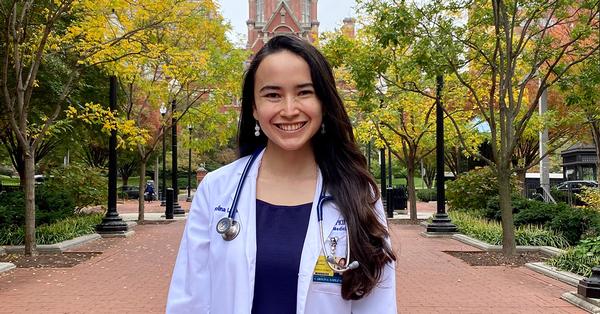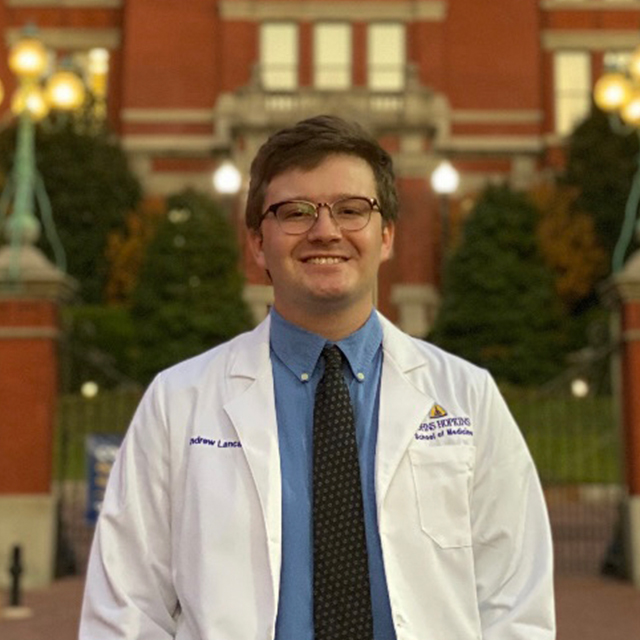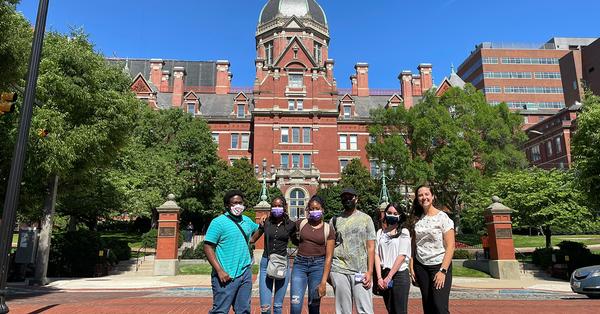School of Medicine Student Helps Food Pantry Run Smoothly
Huang ensures that food distribution and volunteering are efficient and easy

School of Medicine student Emily Huang
As an undergraduate student, Emily Huang served as director of the University of Utah’s food pantry. When she enrolled at the Johns Hopkins University School of Medicine, she wanted to continue working in the community. Now, Huang is part of a team that has provided more than a million pounds of food to 49,000 families through the food pantry at Elmer A. Henderson: A Johns Hopkins Partnership School.
Huang started volunteering in the summer of 2022. The food pantry program had grown, and organizers brought Huang on board to support the organization and sustainability of the program. She also assists with volunteer recruitment and tracking, data management, calculating leveraged funds and sometimes helps distribute the food directly to neighbors.
“I always thought volunteering meant directly interacting with the clients. However, I now see that there’s a lot of important work behind the scenes to ensure continuity of food distribution, funding and volunteers, so we can be a reliable food resource for our community members,” says Huang, now in her second year of medical school.
Before the COVID-19 pandemic, Elmer A. Henderson: A Johns Hopkins Partnership School (also known as Henderson-Hopkins) provided 1,000 meals daily to their student body, with a comprehensive meal program that included breakfast, lunch, snack and supper.
When in-person school closed on March 12, 2020, due to the pandemic, school officials were worried about the impact of not being able to provide meals to students. So, they called the Maryland Food Bank and arranged for the organization to bring fresh foods to the school weekly. The first Henderson-Hopkins food pantry distribution event was held on March 31, 2020, and has taken place every Friday afternoon ever since.
The food pantry strives to provide a wide variety of options, including bags filled with canned vegetables and fruits, pasta, beans, rice, soup, macaroni and cheese, cereal, pancake and muffin mixes, peanut butter and jelly.
“Volunteering with the food pantry has been an incredible and eye-opening experience,” Huang says. “I’ve helped streamline pantry operations and expand program capacity to help more members of our community.”
Huang also notes that her volunteer work has given her a better idea of Baltimore’s community issues.
“I’ve seen how the pandemic has impacted the community, with the increased prevalence of food insecurity,” she says. “People often line up for the food pantry before we open. I’ve seen the look of relief on our clients’ faces, as our volunteers fill their cars with boxes of food, and I’m honored to share in the happiness they feel when they get the support they need.”
Henderson-Hopkins community school coordinator Annie Weber says she was relieved when Huang asked to volunteer.
“She was ready to help,” Weber says. “Emily is extremely hardworking and very smart. It’s a comfort to know that I have someone dedicated to the betterment of the community. She always asks what she can do next.”
Education consultant J.D. Merrill is Henderson-Hopkins’ former assistant principal. He’s watched the program grow and says Huang’s help has been instrumental.
“The first thing I noticed was how thankful Annie was for the help,” Merrill says. “Emily helped revamp the data tracker, and she helped organize our volunteer recruitment outreach.”
Weber says East Baltimore is described as a healthy food priority area by Baltimore’s Department of Planning and by the Health Department. Henderson-Hopkins continues to serve as a hub for healthy food, and the community has come to rely on its food pantry.
“We see a lot of the same people each week. With inflation, we’re seeing many more people show up. We’re working hard to remain a reliable source for our neighbors,” Weber says.


